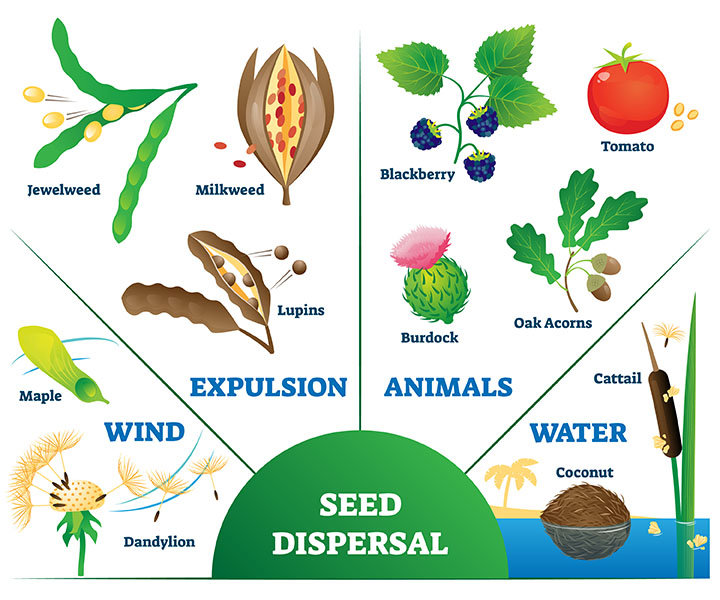
< Back
seed dispersal
Definition
Seed dispersal is the process of moving seeds away from the parent plant. This helps to ensure that the seeds will germinate in a new location and that the plant will be able to reproduce.
There are many different ways that seeds can be dispersed. Some of the most common methods of seed dispersal include:
- Wind dispersal: Seeds that are dispersed by wind are often light and have wings or hairs that help them to catch the wind. When the wind blows, the seeds are carried away from the parent plant.
- Animal dispersal: Seeds that are dispersed by animals often have hooks or spines that help them to attach to the fur or feathers of animals. When the animal moves, the seeds are carried away from the parent plant.
- Water dispersal: Some seeds are adapted to float in water and can be carried long distances by rivers or oceans.
- Gravity dispersal: Some seeds are simply dropped from the parent plant and fall to the ground.
- Self-dispersal: Some seeds have special mechanisms that allow them to launch themselves away from the parent plant.
The method of seed dispersal that a plant uses is often influenced by its environment. For example, plants that live in windy areas often have seeds that are adapted to wind dispersal. Plants that live in areas with a lot of animal activity often have seeds that are adapted to animal dispersal.
Seed dispersal is an important process for plants. It helps to ensure that the seeds will germinate in a new location and that the plant will be able to reproduce. Seed dispersal also helps to spread plants to new areas, which can help to increase the diversity of plant life in the world.
How can the word be used?
Animals, such as birds and bats, also disperse seeds.

Different forms of the word
Noun:
- the movement of seeds away from the parent plant.
Etymology
The word "seed dispersal" is a compound word, consisting of the words "seed" and "dispersal".
The word "seed" comes from the Old English word "sæd", which also means "seed".
The word "dispersal" comes from the Latin word "dispersio", which means "scattering".
The first recorded use of the word "seed dispersal" in English was in the 19th century.
The word "seed dispersal" is an English word, and it is not related to any other languages.
Question
Provide three examples of seed dispersal.
AQA Science Exam Question and Answer
Question:
Discuss the different mechanisms of seed dispersal in plants and explain how each adaptation enhances the survival and distribution of plant species.
Answer:
Seed dispersal is a crucial survival strategy for plants, ensuring the spread of offspring to new environments. Various mechanisms facilitate this process. Wind dispersal, or anemochory, involves lightweight seeds equipped with structures like wings or hairs that catch the wind and carry seeds away from the parent plant. This adaptation aids plants in colonizing distant locations and reduces competition for resources.
Animal dispersal, or zoochory, relies on animals to transport seeds. Some seeds have hooks, barbs, or sticky substances that attach to fur or clothing, allowing seeds to hitch a ride and be deposited far from the parent plant. Edible fruits entice animals to consume them, and seeds survive passage through the digestive tract, often germinating in a new location where they're deposited.
Water dispersal, or hydrochory, is observed in aquatic or riparian plants. Buoyant seeds float on water, transporting them downstream or across bodies of water, eventually finding suitable soil for germination.
Explosive mechanisms, or ballistic dispersal, involve the sudden release of tension, propelling seeds away from the parent plant. This strategy, seen in plants like the touch-me-not or witch hazel, provides rapid distribution and prevents overcrowding.